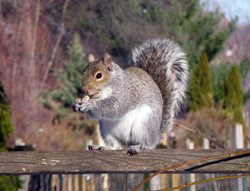
Until recently, Etienne Benson, an assistant professor in the University of Pennsylvania’s Department of History and Sociology of Science, consciously chose to investigate a creature that may be considered less exotic, and is certainly smaller for his latest publication. “I wanted to write about something a bit closer to home, about things we see and encounter every day,” Benson said. So he turned his attention to the squirrel.
His paper, “The Urbanization of the Eastern Gray Squirrel in the United States,” published in the December issue of the Journal of American History, examines how the now-ubiquitous bushy-tailed critters found homes in American cities, and how their presence there altered people’s conceptions of nature and community.
“By the mid-19th century, squirrels had been eradicated from cities,” he said. “In order to end up with squirrels in the middle of cities, you had to transform the urban landscape by planting trees and building parks and changing the way that people behave. People had to stop shooting squirrels and start feeding them.” In researching the history of squirrels in American cities, Benson found the first documented introduction occurred in Philadelphia’s Franklin Square in 1847. Other introductions followed in Boston and New Haven in the 1850s. These early releases were small in scale, and intended to “beautify and add interest to the parks,” Benson says.
The presence of squirrels in cities at this time “started getting tied up with the parks movement led by Frederick Law Olmstead,” Benson said. “It was related to the idea that you want to have things of beauty in the city, but it was also part of a much broader ideology that says that nature in the city is essential to maintaining people’s health and sanity, and to providing leisure opportunities for workers who cannot travel outside the city.”Benson also found signs in his research that squirrels played another important role for city residents, particularly children: as moral educators. “Feeding squirrels becomes adopted as a way of encouraging humane behavior,” Benson said.
By the first couple of decades of the 20th century, some of the rosy glow toward squirrels had faded, Benson noted. Booming populations began to annoy some city residents, as the animals took up residence in attics, bit people trying to feed them, dug up gardens and scared away songbirds from feeders.
By the time the environmental movement took hold in the 1960s and 1970s, Benson argued, squirrels in the urban environment were no longer widely seen as morally significant members of the community and instead began to be viewed with a more ecological mindset. Ideas of letting them live out life “as nature intended” took a stronger hold.
Squirrel Issues
According to The Humane Society of the US, “If you’ve got squirrels driving you nutty, remember that they’re only doing what’s natural: looking for a meal and a safe place to sleep at night. Whether you need to evict them from your attic or stop them from stealing your bird food, be patient and look for a way that won’t harm the critters or their young.” The Humane Society offers several other tips for dealing with squirrels on their website.